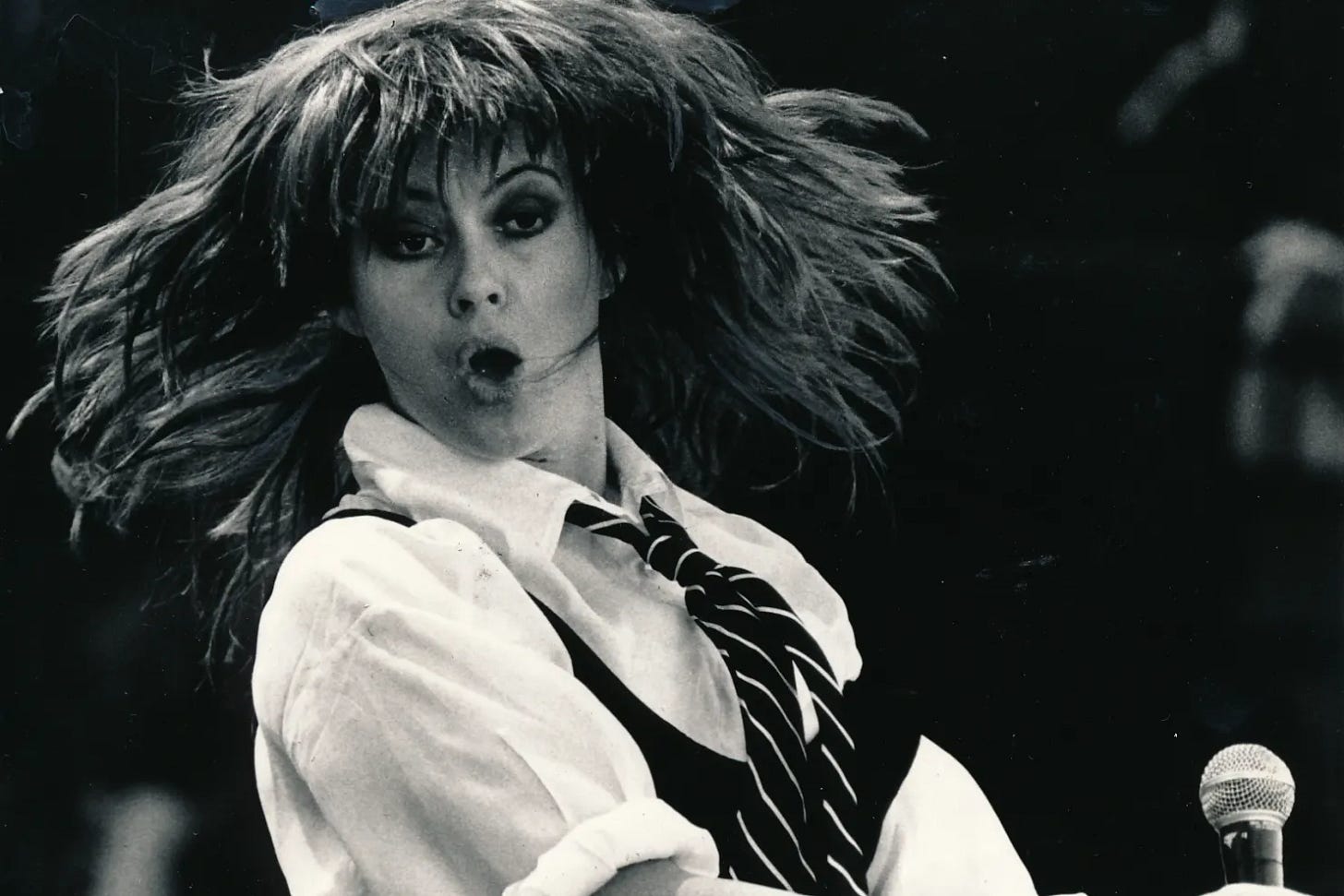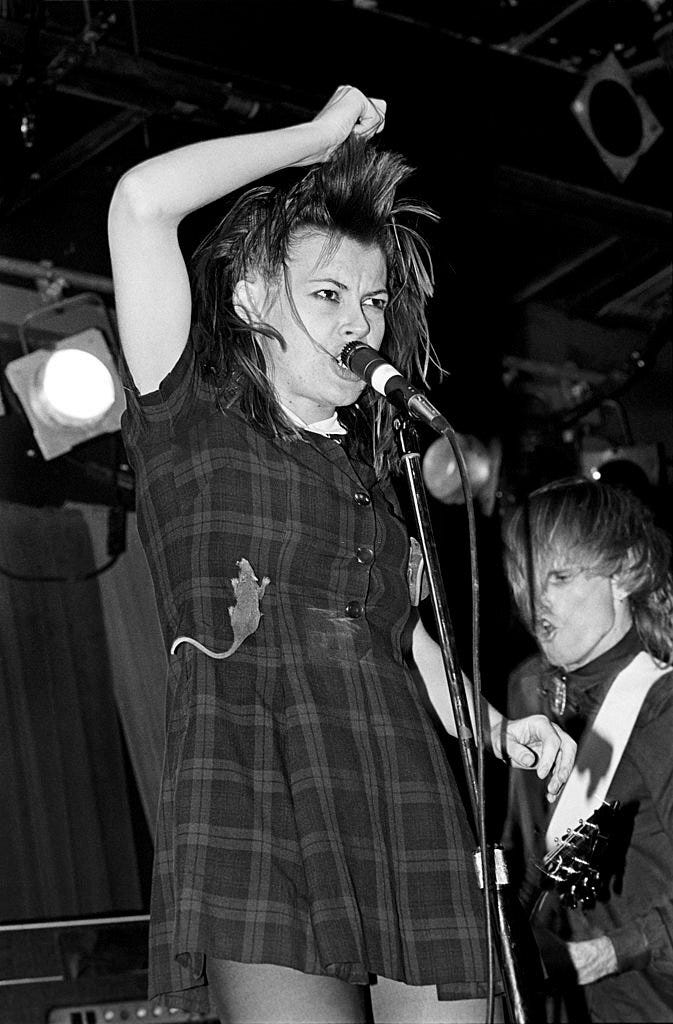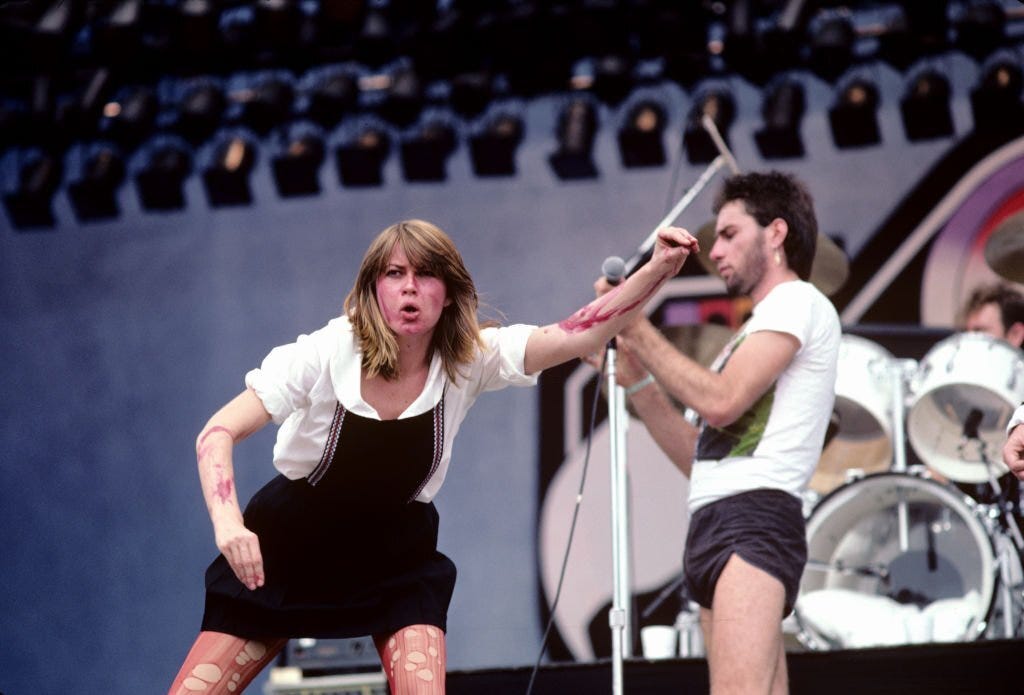Why Chrissy Amphlett's school uniform was a revolution
The lead singer of Divinyls was known for donning a schoolgirl's tunic when performing onstage. But combined with her attitude, it became so much more.
The visual of the school uniform-wearing rock musician is not an unfamiliar one to most. For many, AC/DC’s Angus Young is synonymous with his high school blazer-and-tie ensemble. But he’s not the only Australian musician who became associated with such an image. Enter Chrissy Amphlett, the frontwoman of Sydney rock band Divinyls.
Formed in 1980, Divinyls had a string of hits down under, including ‘Boys In Town’, ‘Science Fiction’, and ‘Pleasure and Pain’. Conversely, they’re regarded as a one-hit wonder overseas in the US, with only one successful single: ‘I Touch Myself’. A song that celebrated female masturbation and eroticism, its controversial subject matter required a great deal of confidence to sing it. No one was better suited for the role than Chrissy Amphlett. Known for her wild stage presence, Amphlett would scream, headbang, and kick or punch anyone who got in her way.
“Chrissy was the master of the humiliating putdown. A bloke who didn’t know better would yell something like ‘show us your tits!’ and she’d stop the show, order the lights turned on and jump down and confront him. ‘Yeah mate?’ she’d yell right into his face, ‘Well show us your dick!’ The bloke would shrivel.”
— Rick Grossman, taken from Pleasure and Pain: My Life
Yet this feisty attitude often concealed a much different side to Amphlett. Behind closed doors, she was incredibly shy. In the early days of Divinyls, Amphlett stood far away from the audience, hiding behind a scowl and her thick fringe. It didn’t matter that she was an experienced singer - her life pre-Divinyls had often involved busking in the streets of Melbourne - Amphlett preferred to stand at the back with the drummer.
Their manager, Vince Lovegrove, suggested that the solution was ‘a bit of dirt and splatter’. He’d seen Amphlett act confrontationally and provocatively before. If they could bring that part of her to the fore again, Divinyls would be a success. And so it was that Amphlett adopted the persona of the ‘angry schoolgirl’.
Personas are a common occurrence in the world of rock. Artists can retreat into a character, assume a different role to the one life deals them. And it captivates audiences: nobody wants to see David Jones - they aren’t compelled by him. They’re compelled by Ziggy, by the Thin White Duke. How much of the persona is the real person and how much is the performance? The artist gets to pick and choose what the audience is allowed to know and what they’re not - what they’re attracted to and repelled by.
“I wanted to be wild. I wanted to be provocative. I wanted to express myself and jolt the audience out of their comfort zone. But I wasn’t game. Part of my problem was that I had written passionate, raw songs, but I was too shy to perform them with the emotional abandon they deserved.”
— Chrissy Amphlett, Pleasure and Pain: My Life
After Lovegrove took Amphlett to see an AC/DC concert, she was inspired by Angus Young’s schoolboy look to go out and buy a uniform, suspenders and stockings. The outfit would undergo changes here and there: different dresses, stockings ripped, rubber rats pinned onto the tunic, and lipstick smeared everywhere as if it were blood. But the difference between Young and Amphlett was that Young’s getup was a part of a gimmick that had been used to make his band memorable; Amphlett’s schoolgirl fashion was a means of drawing out her confidence. As Lovegrove noted:
“She was transformed. She tore around the stage like a banshee, haranguing the crowd and the band, scowling, screaming, headbanging, and all the while singing the songs perfectly…the audience was astonished and terrified. She came off the stage emotionally shredded, dripping with sweat, and smiling from ear to ear. Suddenly Chrissy Amphlett was one of the most electrifying performers on earth. Divinyls would never be the same again.”
The change in appearance was not just groundbreaking for Amphlett. At that time, there were no ‘provocative’ female rock singers in Australia. Amphlett’s cousin, Patricia Amphlett, was a famed sixties singer who performed under the name Little Pattie. When asked about her experiences as a female performer, she explained: “our desired image on Bandstand was that of a virtuous, virginal, clean-cut girl-next-door”.
Amphlett also stated that in spite of her growing success in the sixties, she would constantly be billed second in favour of a male performer.
“Promoters couldn’t bear to put a woman at the top of the bill.”
It didn’t matter what genre of music they were involved with. Whether it be rock, pop, folk, or jazz, women were all supposed to fit the same mould of pretty and non-threatening, according to Chrissy Amphlett.
“Australia needed a monster, and I decided I could be it.”
The schoolgirl uniform, especially the sailor fuku in Japan, has been sexualised time and time again. Not only does it reinforce this ‘non-threatening’ image, but it also conveys a type of innocence - in particular, a sexual innocence that certain men find irresistible. Many women and female performers are subjected to this paradoxical image wherein they are expected to look naive and pure, yet somehow they’re also fuckable and could give you an incredible blowjob. It’s an impossible balancing act to maintain, a Catch-22 that does nothing but cater to the male gaze.
With her tunic and ripped stockings, Amphlett grabbed this patriarchal view of women and shattered it. Any notion of vulnerability and innocence was immediately destroyed by her wild onstage behaviour. Scowling, swearing and screaming, Amphlett had reclaimed her own individuality, her own autonomy, from people who had decided how she needed to behave. Being a woman in the music industry is a tough job: constant sexualisation, harassment, and being taken less seriously because of your gender undoubtedly leads to pent up frustration.
“I didn’t decide to be a provocative banshee on stage all of a sudden. That developed as a result of all the heckling I would get from the audience and from other bands and their roadies…I was often treated like dirt. I wouldn’t put up with that and [I would] lash out and say, ‘Don’t you dare fuck with me because I’m wearing this school uniform. In fact, fuck you all!’”
— Chrissy Amphlett, Pleasure and Pain: My Life
No longer did Amphlett need to hide behind a scowl and her fringe. Now she could release it all through this persona that ‘did people’s heads in’. The patriarchy is a restricting, controlling thing that asserts an almost vice-like grip over what women can and can’t do, yet this uniform gave Amphlett a freedom to do whatever she wanted.
“I owned that stage,” she wrote in her memoir. “And the audience in front of it.”
“Girls considered her an ally, not a rival. That was her magic,” said Vince Lovegrove. “Gay guys were crazy about her. Beefy testosterone charged lads not so much. Her message to them was, ‘Sorry fellas, your days of lording it over women are over. It’s payback time.’”
Later on during the nineties, the riot grrrl movement would explode into popularity. Spearheaded by bands such as Bikini Kill and Bratmobile, riot grrrl wove feminism and punk rock together with aggression and defiance. Spitting (and scowling) in the faces of men, this ferocity had echoes of Chrissy Amphlett within it. But before riot grrrl, she was a movement all by herself, reclaiming who she was before anyone could define her.
“I was surrounded by so many men,” said Amphlett in a 2013 ABC interview. “And so the uniform was (me giving) the finger to everyone. And the audience, as they tried to think that they could have their way with me, I would react and get in first... and become this monster and then I had the power.”






